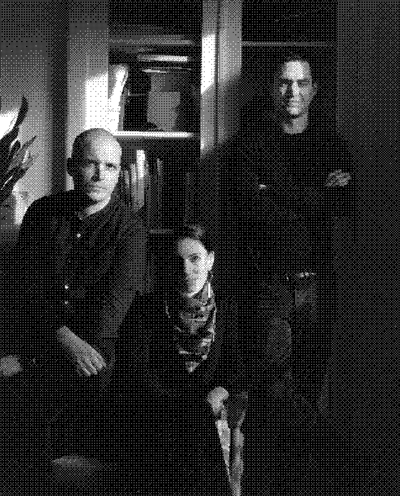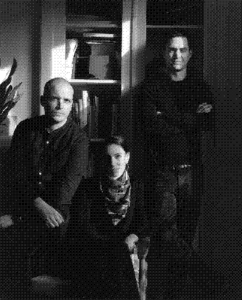References Development Strategy Advice Management Prospective Creativity Clients Communication Process Prospection Work culture Competition Presentation Design Typography Agents Advertising Ai Finance Architecture Investment Education Cgi Trend Fashion Recruitment Graphic design Nft Music Marketing Photography Sound design Research Blockchain Sustainability Crypto Technology Metaverse
15 excerpts on the topic “Advertising”
[…] My love for typography and the ability to showcase work through it really drove this. Typography needs something to say, and as someone who isn’t necessarily a writer, it’s easy to come up with quick phrases like “award-winning creative tech company”—which doesn’t mean anything but looks great in the typography I’m working with. I’m someone who will sacrifice the words for the type itself. I think I liked the way “award-winning” sat on top of “creative tech company”—it just worked together visually. […]
[…] As a designer, we are too often positioned under someone who holds the creative power, limiting you to a mere executor of ideas. In an ad agency, where design isn’t the protagonist, you’re seen as a tool—brought in to make things look good while creative directors and strategists shape the larger vision. I’ve always believed that as a designer, we are inherently strategic and we have more to offer than most care to recognize. […]
[…] It is amazing to see that some big companies don’t get talents anymore because they don’t offer them anything. They are using people to produce things (…) And these kids are not stupid. Having a pizza offered after ten pm, working seven days a week on shitty presentations, they understood and the clients also understood. They are big ships, they are slow, they cost a lot. Clients started to trust smaller teams: they are more flexible and they feel confident. […]
[…] Yes, brands want a different perspective because, ultimately, they want to become — or stay relevant. They want to invest themselves in culture. And this is something that the classic agency model can’t do. […]
[…] Clients come directly to us much more often these days because the agencies take an enormous cut. They have a lot of employees to pay. We’re very open to listening to people, we’re a small company, so the client doesn’t talk to the assistant or whatever. We’re much more able to come up with what they want. You take a big agency campaign budget, you divide that by ten studios and everybody’s happy without being underpaid. […]
[…] That helps you grow. Also, you have to work quickly, there’s immediacy for example when 10 ADs before you failed and you’ve got one hour to come up with something for a huge client. Making it work in one hour is how you learn. Teamwork also takes some learning. Working with the marketing people, the planner, the suits… I learned all of that through working in agencies, though I don’t necessarily go about my business that way now. I also learned about “ideas sales”. A big creative director or agency director selling their project to a big client is something to see. […]
[…] Everybody says that advertising is ugly, but you see it everywhere and it definitely won’t ever change if nobody tries to inject a little design into it… Luckily enough you do find ad agencies with artistic directors who share that mindset. […]
[…] DEV What did the agency teach you about presenting your work?
MA: Post-rationalisation. I still use it now. When at the start of a project I don’t have any precise ideas, I search, I experiment, I run a few intuitive tests, and once I’ve got visuals that make sense, I formulate the idea. When presenting the visual to the client I link what I have produced to the subsequent idea. It sounds like a con job, as if we were snowing the client but intuition rules because intuition makes sense. […]
MA: Post-rationalisation. I still use it now. When at the start of a project I don’t have any precise ideas, I search, I experiment, I run a few intuitive tests, and once I’ve got visuals that make sense, I formulate the idea. When presenting the visual to the client I link what I have produced to the subsequent idea. It sounds like a con job, as if we were snowing the client but intuition rules because intuition makes sense. […]
[…] Ageism is something I witnessed a lot in agencies. I now know how to spot it in my clients. Ageism means you want to do “young,” “cool” things. Whereas it might be more satisfying to accept that you are old and corny, or simply yourself. […]
[…] The art of the brief is difficult. A brief both clear and precise is rare. For a designer, deciphering a brief is the challenge. It’s not the client’s job to prepare briefs, except for communications managers. Which brings me to another piece of advice I would give: learn to decipher a brief, ask the client loads of questions, interest yourself in their business, the better to understand them. What does the client want beyond what they are telling you? […]
[…] What I really learned about that time is that the thinking in advertising is very strategic. It’s not that creative, it’s a very pragmatic and a very strategic thinking that you actually need. Because the bigger the brand, the easier and the more versatile the message must be. […]
[…] During my experience in advertising, I couldn’t experience anything of that because everything was planned, so the photographer’s not creative, the illustrator’s not creative, everybody’s just working for the client and you have a lot of correction loops. So any “happy accident”, as Bob Ross would say, can’t happen because everything’s extremely planned. […]
[…] Remember when you went to the movies and you were actually happy to see those 15 minutes of advertising? Remember that time? And you would say: “Jeans… Levis … ah, nice! New message, I haven’t seen that one”. We had these times. And now clients are a big marketing thing: all these surveys, what everybody wants, how to convince and be convenient to everybody, wanting to be liked by everybody. Brands and products have this problem too. If you go to the annual Milan Salon, over all these years, all these new chairs are coming out. They all look like one another. There’s almost no signature piece behind it anymore. No one is daring. […]
[…] When I started as a professor, my first talks in universities, when I asked who in the room wanted to become a graphic designer and who was aiming for advertising, there were only two future graphic designers and a majority wanting to go into advertising. If I do a talk now and dare to ask who’s going into advertising, almost none of them are. That also means that the industry doesn’t really have any new talents coming up. […]
[…] One of the other problem is that all this generation of young marketing guys have changed sides from agency to client. And they are now the leading points in the marketing department of these big companies and they haven’t learned differently, they only have one way.
You guys are also teaching in these schools. You still know that if you have an ‘after’ in a club in France where all these advertising people are running around and you’re talking to them about their industry, none of them would ever admit how bad the quality is at the moment. […]

